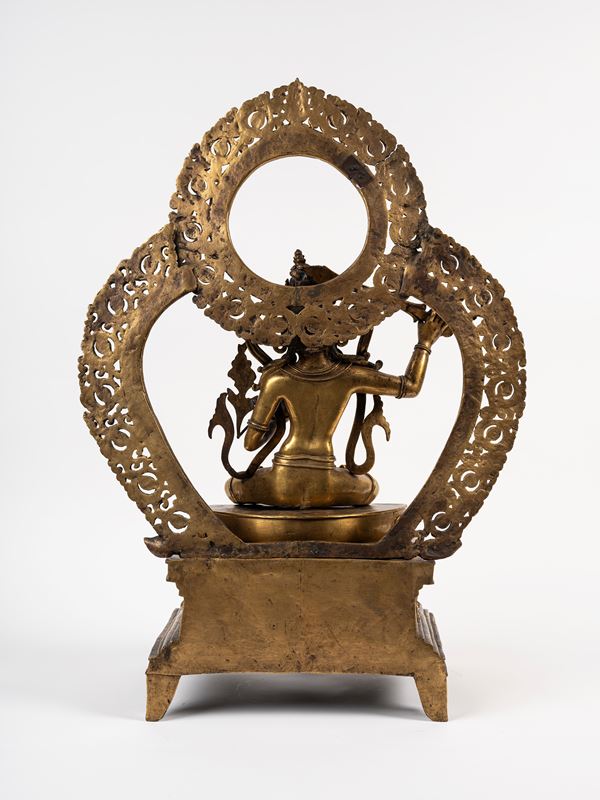231
AN IMPORTANT AND LARGE GILT-BRONZE FIGURE OF MANJUSHRI, China, Qing dynasty, possibly 18th century
h cm 60
Seated in dhyanasana on a lotus base, with his right hand raised holding a sword and his left in vitarka mudra holding the stem of an uptala lotus that rises to shoulder height. The dhoti is secured with a belt, leaving the bodhisattva’s torso exposed. He is adorned with elaborate jewelry embellished with turquoise and flowing drapery. The figure rests above a draped banner on a throne supported by two snow lions, from which rises a finely carved and pierced flame with a halo.
Provenance: Private collection, Italy.
Catalog Notes:
The serene face of this Himalayan-inspired sculpture is found in other figures of Manjushri in various manifestations, as seen in the 18th-century Tibetan Manjughosha figure at the Palace Museum in Beijing, illustrated in The Palace Museum 2002, Iconography and Styles, Tibetan Statues in the Palace Museum, Beijing, pp. 326–327, no. 139. The hand style is also similar.
See also the face of the Tara from the Imperial Workshops in Beijing, also in the Palace Museum and illustrated in op. cit., p. 358, no. 154, with an expression very similar to this Manjushri, possibly implying a similar manufacturing attribution.
On the present lot, XRF analyses have been performed in two points, respectively on the stand, on the head nearby the blue pigments, on the flame and underneath the figure. The chemical analyses reported in this catalog were conducted using an Olympus XRF analyzer, model VCR-CCC-A3 (SN: 823330), equipped with a 40 kV Rhodium tube. Measurements were carried out with an acquisition time of 30 seconds per sample and an analysis radius of 2 millimeters.
See also the face of the Tara from the Imperial Workshops in Beijing, also in the Palace Museum and illustrated in op. cit., p. 358, no. 154, with an expression very similar to this Manjushri, possibly implying a similar manufacturing attribution.
On the present lot, XRF analyses have been performed in two points, respectively on the stand, on the head nearby the blue pigments, on the flame and underneath the figure. The chemical analyses reported in this catalog were conducted using an Olympus XRF analyzer, model VCR-CCC-A3 (SN: 823330), equipped with a 40 kV Rhodium tube. Measurements were carried out with an acquisition time of 30 seconds per sample and an analysis radius of 2 millimeters.
Please note that the element labeled as W (Tungsten) in the results should be interpreted as Au (Gold). The results are expressed as percentages (%) for elements present in larger quantities and in parts per million (PPM) for those present in trace amounts. It is worth noting that 1 PPM corresponds to 0.0001%.
To view the PDF analysis report, please refer to the following link: XRF chemical analysis
铜鎏金文殊菩萨像,中国,清朝,可能是18世纪
此菩萨像坐于莲花宝座之上,头戴花冠,发髻高耸,耳垂圆珰。面相方圆,丰满端正,表情肃穆。宽肩束腰,身体比例合理,造型优美。胸前配饰项圈璎珞,手、臂、踝都饰有钏环。躯体身后为葫芦形光背,边缘为火焰形,制作精致,莲花座上缘饰有一圈连珠纹,莲瓣饱满饱满,制作精致。莲花座下方为方形须弥座,前有座垫自然垂下。
北京故宫博物院藏类似的18 世纪西藏文殊菩萨像,并在《故宫博物院 2002 年,图像学和风格,故宫博物院藏藏造像,北京,第17页。 326-327,n。 139 的风格也很相似。
此菩萨像坐于莲花宝座之上,头戴花冠,发髻高耸,耳垂圆珰。面相方圆,丰满端正,表情肃穆。宽肩束腰,身体比例合理,造型优美。胸前配饰项圈璎珞,手、臂、踝都饰有钏环。躯体身后为葫芦形光背,边缘为火焰形,制作精致,莲花座上缘饰有一圈连珠纹,莲瓣饱满饱满,制作精致。莲花座下方为方形须弥座,前有座垫自然垂下。
北京故宫博物院藏类似的18 世纪西藏文殊菩萨像,并在《故宫博物院 2002 年,图像学和风格,故宫博物院藏藏造像,北京,第17页。 326-327,n。 139 的风格也很相似。












































